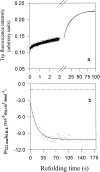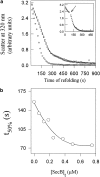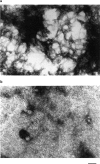Reversible formation of on-pathway macroscopic aggregates during the folding of maltose binding protein
- PMID: 11468360
- PMCID: PMC2374092
- DOI: 10.1110/ps.8101
Reversible formation of on-pathway macroscopic aggregates during the folding of maltose binding protein
Abstract
Maltose binding protein (MBP) is widely used as a model for protein folding and export studies. We show here that macroscopic aggregates form transiently during the refolding of MBP at micromolar protein concentrations. Disaggregation occurs spontaneously without any aid, and the refolded material has structure and activity identical to those of the native, nondenatured protein. A considerable fraction of protein undergoing folding partitions into the aggregate phase and can be manually separated from the soluble phase by centrifugation. The separated MBP precipitate can be resolubilized and yields active, refolded protein. This demonstrates that both the soluble and aggregate phases contribute to the final yield of refolded protein. SecB, the cognate Escherichia coli cytosolic chaperone in vivo for MBP, reduces but does not entirely prevent aggregation, whereas GroEL and a variety of other control proteins have no effect. Kinetic studies using a variety of spectroscopic probes show that aggregation occurs through a collapsed intermediate with some secondary structure. The aggregate formed during refolding can convert directly to a near native state without going through the unfolded state. Further, optical and electron microscopic studies indicate that the MBP precipitate is not an amyloid.
Figures









Similar articles
-
Interaction of SecB with intermediates along the folding pathway of maltose-binding protein.Protein Sci. 1995 Jun;4(6):1118-23. doi: 10.1002/pro.5560040610. Protein Sci. 1995. PMID: 7549876 Free PMC article.
-
Mutations of the molecular chaperone protein SecB which alter the interaction between SecB and maltose-binding protein.J Biol Chem. 1993 Jan 25;268(3):1590-5. J Biol Chem. 1993. PMID: 8420934
-
Demonstration in vivo that interaction of maltose-binding protein with SecB is determined by a kinetic partitioning.J Bacteriol. 1995 Jun;177(11):3277-82. doi: 10.1128/jb.177.11.3277-3282.1995. J Bacteriol. 1995. PMID: 7768828 Free PMC article.
-
The dynamics of the MBP-MalFGK(2) interaction: a prototype for binding protein dependent ABC-transporter systems.Biochim Biophys Acta. 2008 Sep;1778(9):1772-80. doi: 10.1016/j.bbamem.2007.09.005. Epub 2007 Sep 19. Biochim Biophys Acta. 2008. PMID: 17950243 Review.
-
The remarkable solubility-enhancing power of Escherichia coli maltose-binding protein.Postepy Biochem. 2016;62(3):377-382. Postepy Biochem. 2016. PMID: 28132493 Review. English.
Cited by
-
N-terminal domains of native multidomain proteins have the potential to assist de novo folding of their downstream domains in vivo by acting as solubility enhancers.Protein Sci. 2007 Apr;16(4):635-43. doi: 10.1110/ps.062330907. Protein Sci. 2007. PMID: 17384228 Free PMC article.
-
Folding of a large protein at high structural resolution.Proc Natl Acad Sci U S A. 2013 Nov 19;110(47):18898-903. doi: 10.1073/pnas.1319482110. Epub 2013 Nov 4. Proc Natl Acad Sci U S A. 2013. PMID: 24191053 Free PMC article.
-
Slow and bimolecular folding of a de novo designed monomeric protein DS119.Biophys J. 2013 Nov 5;105(9):2141-8. doi: 10.1016/j.bpj.2013.09.014. Biophys J. 2013. PMID: 24209859 Free PMC article.
-
Artificial chaperone-assisted refolding of GuHCl-denatured alpha-amylase at low temperature: refolding versus aggregation.Protein J. 2005 Jul;24(5):303-13. doi: 10.1007/s10930-005-6751-y. Protein J. 2005. PMID: 16284728
-
Comparative evaluation of alpha-amylase refolding through two different artificial chaperone systems.Protein J. 2007 Aug;26(5):293-301. doi: 10.1007/s10930-007-9071-6. Protein J. 2007. PMID: 17516156
References
-
- Agashe, V.R., Shastry, M.C., and Udgaonkar, J.B. 1995. Initial hydrophobic collapse in the folding of barstar. Nature 377 754–757. - PubMed
-
- Anfinsen, C.B. 1973. Principles that govern the folding of protein chains. Science 181 223–230. - PubMed
-
- Betton, J. and Hofnung, M. 1996. Folding of a mutant maltose-binding protein of Escherichia coli which forms inclusion bodies. J. Biol. Chem. 271 8046–8052. - PubMed
-
- Betton, J.M., Sassoon, N., Hofnung, M., and Laurent, M. 1998. Degradation versus aggregation of misfolded maltose-binding protein in the periplasm of Escherichia coli. J. Biol. Chem. 273 8897–8902. - PubMed
-
- Brems, D.N. 1990. Deciphering the second half of the genetic code. In Protein folding (eds. L.M. Gierasch and J. King), pp. 129–135. American Association For The Advancement of Science.
Publication types
MeSH terms
Substances
LinkOut - more resources
Full Text Sources
Research Materials
Miscellaneous

